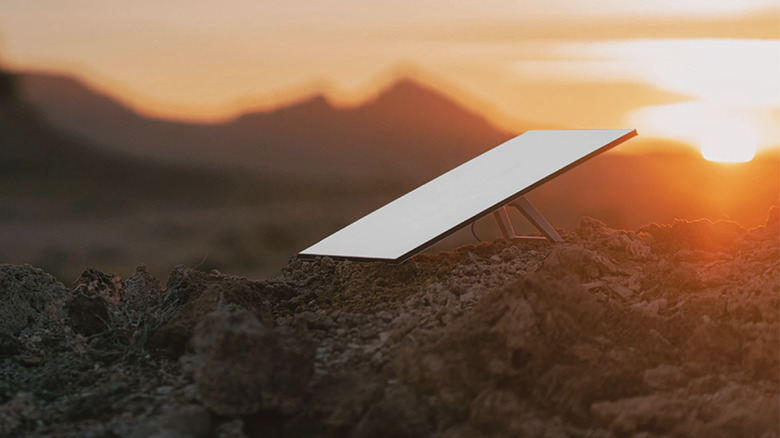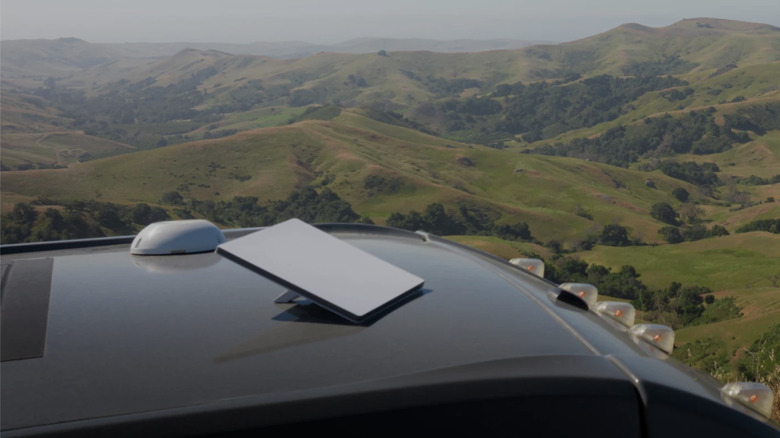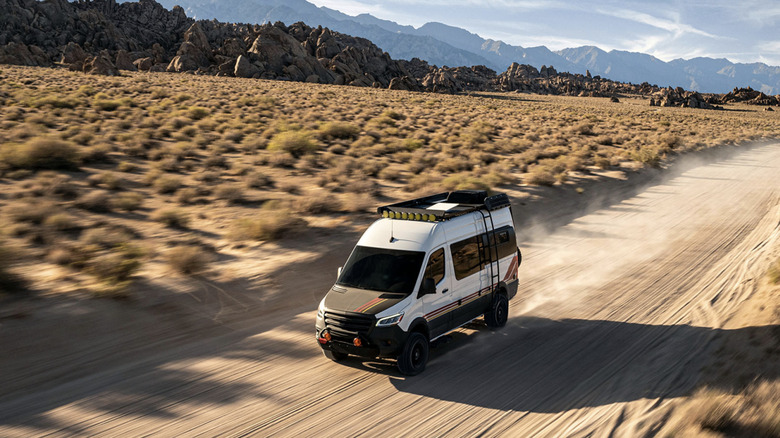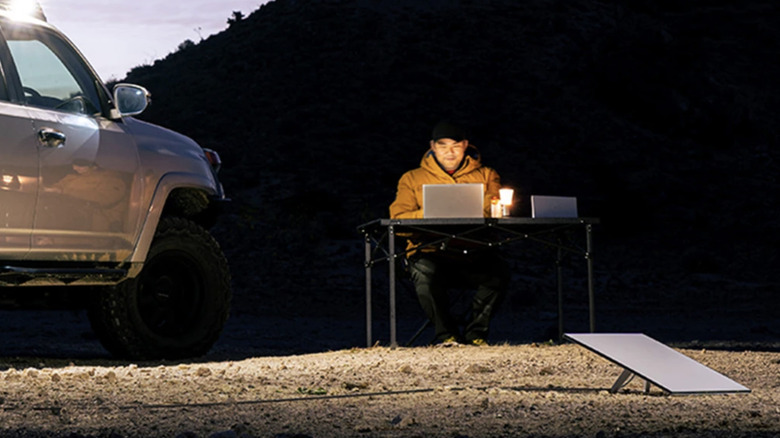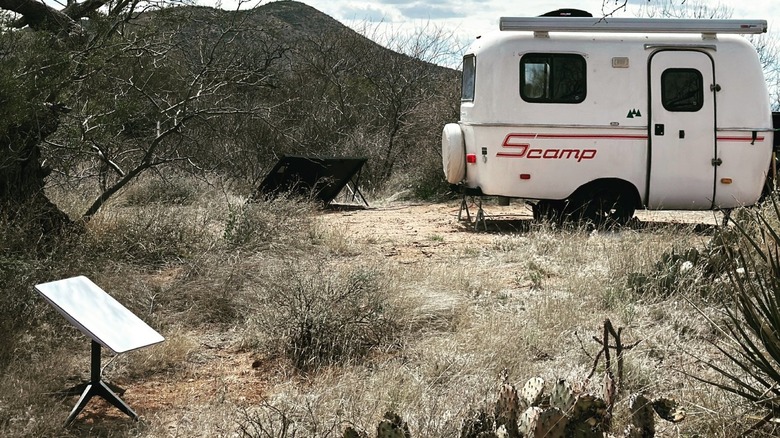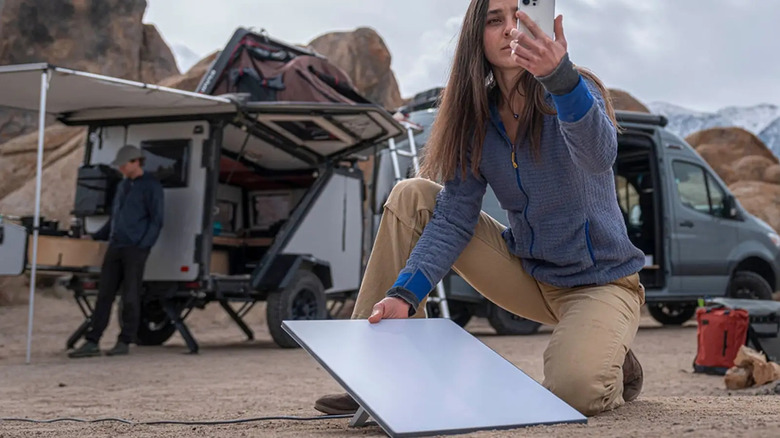Starlink For Camping: The Best Dish And Plan Options Explained
We may receive a commission on purchases made from links.
Starlink has come a long way since the first Starlink satellites launched in 2019 on a SpaceX Falcon 9 rocket. Since then, SpaceX has been sending out new satellite batches to ensure that its product is as strong and reliable as it can be. Meanwhile, availability for the service has grown, and the plans have had upgrades providing more options for various needs. There are three plans currently — Residential, Roam, and Boats. Each comes with different features and prices.
Starlink and its Roam plan have changed the way that nomads like myself, people who travel for work, and outdoor adventurers can use the internet. In fact, it's nearly become a must-have gadget. We don't have to scour towns looking for coffee shops with decent wifi to connect to. Instead, we can simply hook Starlink up to a power source and go.
That said, when you look at Starlink's website, you'll see several dishes along with more than one Roam service plan. Without having to dig through tabs and discussion boards, here are the best plan and dish options for different types of camping and traveling. I'll also share a bit of my own experience with Starlink and tips when using it for your mobile adventures.
Roam service plan options explained
Unlike the standard Residential plan, which only comes with one unlimited plan for the price of $120 per month, Roam comes with two service plans to choose from based on your needs. The first is the 50GB plan for $50 per month. Starlink states that 50GB is approximately 20+ hours of high-definition video streaming. However, if you only plan on using Starlink during camping weekend for internet searching and staying connected for wilderness safety purposes, then 50GB should be plenty. That said, if you find that you do need a bit more and want to pay per GB, you can. Starlink doesn't state what the cost is per GB, but according to users and other articles, it is $1 a GB, which isn't bad.
To put it into perspective, while camping out in Colorado for June 2024 with no service, I used Starlink to research for work, watched hours of Netflix, doom-scrolled on Instagram, and spent several hours on video calls. All of these activities led to me using well over 100GB. That said, the 50GB plan wouldn't work for my needs. If you're going to be needing the internet to that extent, or if several people are going to be using the service, the unlimited plan may be the better option. It costs $165 per month. It is pricer than the Residential unlimited plan, but it does come with convenient features that can benefit any type of traveler or camping enthusiast.
Roam's awesome key features
Roam has a handful of features that make it perfect for camping and living life in motion. Firstly, Roam has countrywide coverage within the country of the account address, which includes inland waterways and marinas. However, if you plan on traveling out of the country, you can get up to two months per trip of coverage in available markets, which includes North America, Australia, and most of Europe and South America. Make sure to check out Starlink's Availability Map before you travel.
Roam also includes in-motion use, which means that you can be traveling up to 100 mph and still have connected internet. This feature is great for driving through areas with no cell service or if your family needs to use the internet while resting in the RV while you take the wheel. You can also get coastal ocean coverage up to 12 nautical miles off the coast of areas where Starlink provides active coverage. This lasts for up to five consecutive days at a time and a total of 60 days within a one-year period.
Lastly, with Roam, you have the ability to pause and un-pause your service. However, keep in mind that you are billed in one-month increments. This means that if you pause your service after you pay for a month, you'll continue to have service until the paid month is up. Starlink does not offer refunds. However, it's a great feature if you don't plan on traveling all the time or only need it for long weekend camping trips every once in a while.
Which Starlink dish is best for camping and traveling?
Typically, campers and travelers pack light only bringing the items that can fit in their car, backpack, or RV. Furthermore, if you're not constantly attached to shore power, low power consumption is a necessity. That said, the Mini is a great option for these types of lifestyles due to its size and low wattage consumption. It's around the size of a standard laptop and only consumes an average of 25-40 watts an hour. It comes with the dish, a kickstand, a pipe adapter, and the accessories to hook it up to a power supply for $599. You can also purchase a mobility mount or a roof rack mount for on-the-go service.
Another option that may benefit people who do more streaming, video calls, online games, and other demanding applications is the Standard dish. This dish comes with a router and is a bit bigger, but it's also cheaper than the Mini at $349. On Starlink's website, it is advertised with the Residential plan, but it can still be used with the Roam plan. It's a good option to have if you have a decent power station since the setup averages 75-100 watts an hour. You can also use it year-round between home and traveling if you don't plan on permanently setting it up somewhere.
Personally, I own the older Standard Actuated dish, which was bought and has been consistently used since 2022. It's a bit larger than the two newer dishes mentioned above and uses between 50-75 watts an hour. To add, I've never had a problem with it other than taking up more space. Unfortunately, Starlink is not selling this version any longer, but you can purchase one used from a private seller like on Facebook Marketplace. Just make sure you transfer information properly to set up your Starlink plan. Each of these dishes offers a 110-degree field of view and snow melt capability. They can also operate in a wide range of temperatures.
Starlink tips for camping and traveling
The biggest component of using Starlink is that you need plenty of open skies to ensure that the dish can connect to the satellites. When looking for a spot for Starlink, I would recommend using one of several camping spot apps. I personally use iOverlander more than anything else and when I find a spot, I plug the coordinates into Google Maps on satellite mode to look at the area's landscape. If there are a lot of trees, it's probably going to be a no-go for Starlink and even my solar panels.
Furthermore, a vast power source is going to be a necessity. In my mini camper that I live in during a good portion of the year, I have 400 watts of solar panels feeding into 3,600 watts of battery power. Starlink is a hungry beast of a machine and can drain me down from 100% to 65% on a cloudy day. That said, I usually had it running all day due to work. If you're only planning on using your Starlink Mini in small increments, a Jackery Explorer 1500 may work just fine for your needs.
I also want to point out that traveling with Starlink can be a bit stressful. It's expensive equipment, and you don't want it banging around. Personally, I found that the Project Source Commander 27 Gallon Tote fits perfectly for the packaging that came with the Standard Actuated dish, so everything is in place when I'm on the move. It does take up a bit of space, but it helps keep peace of mind.
Pros and cons of Starlink Roam
The biggest pro is the overall experience. I've used Starlink during crazy storms in Kansas and the windiest of days in Arizona, and the service was still amazing. In my opinion, it's essential for every digital nomad, traveler, or camper who needs internet services. However, I have noticed that if there are a lot of Starlink users in the area, speeds can drop a bit during peak hours, but honestly, it wasn't enough for me to complain unless I was trying to upload a YouTube video.
Also, it can be a bit pricy, especially if you're paying for Roam Unlimited. In the past couple of years of using it, prices seem to keep going up for Roam due to convenience while Residential has stayed the same. It started out at $120 a month, no matter what plan you had.
Furthermore, it's good to keep in mind that though the coolest feature of Roam is the in-motion capability, there are only three dishes that support it — Mini, Standard, and Flat High Performance. This means that you could save money purchasing an older Standard Actuated dish from someone, but it won't have the upgraded features. Though, in my experience, I don't feel like I'm missing out, and it's still a good investment. In the end, though, it's up to you which dish and plan will work best to upgrade your campsite or traveling adventure.
